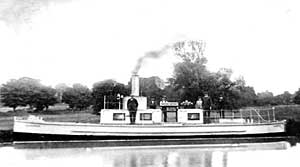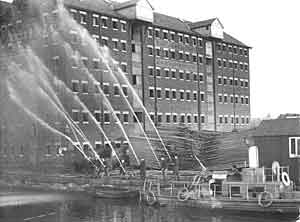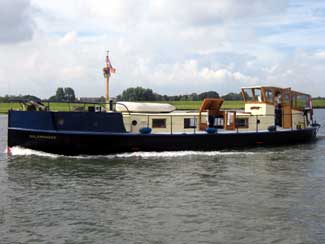For more about
Service Craft, see Bucket Dredgers, Suction
Dredger, SL Sabrina, Steam
Packets, MC Risga
The fire-float Salamander came into service at Gloucester
in 1906, with half the cost paid by local merchants (through the
Chamber of Commerce) and the remainder promised by annual payments
from the Dock Company and Gloucester Corporation. The hull was built
by Abdela & Mitchell at Brimscombe and the pumping equipment
was provided by Merryweather & Sons of London. Propulsion was
by four underwater jets. Once all the debt was cleared, Salamander
was formally handed over to the Corporation in 1909 and continued
in service until disposed of in 1955.
 Three Suspicious Fires Three Suspicious Fires
Within a year of her arrival,
Salamander was called one night to fight a fire at Nicks's
timber yard, about one mile down the canal, and again the following
night at nearby Griggs's yard. The first fire consumed huge stacks
of timber and the second destroyed a large drying shed, but Salamander
and the land-based fire engines were able to prevent damage to the
two saw mills. Concern about the causes of two serious fires on
consecutive nights was strengthened when a third fire was discovered
at Price Walker's timber yard the following day. Fortunately, this
was extinguished before it did any serious damage, and a young employee
eventually confessed to starting all three fires, saying that he
had wanted to see the fire-float at work!
Warehouse Fire
Salamander
was in action again in December 1917 when a fire broke out in the
pillar warehouse on the West Quay and quickly engulfed the building.
The flames also spread to the roof of the neighbouring warehouse
beside the lock, but the efforts of the fire fighters stopped the
fire spreading downward, and this building was saved.
 Successful
Exercise Successful
Exercise
In the early 1930s,
Gloucester Corporation became particularly concerned about the expense
of the fire-float and the time it took to raise steam. It had a
paraffin-fired boiler, but it was necessary to raise 5psi steam
pressure with a wood fire before the paraffin injectors could be
started. In a special test, however, the crew ran from the fire
station and got it pumping in only nine minutes (picture right),
and this was considered so successful that there was no further
talk of getting rid of the fire-float for a long time.
Second World War
During
the Second World War, in case of an air-raid, four crewmen slept
each night in the black hut beside where the fire-float was moored.
However, the only major incident was an accidental fire in the Great
Western Warehouse on the opposite side of the dock in January 1945.
The fire started on a floor where breakfast cereals were being packaged,
and soon huge flames could be seen rising to a height of 150ft.
Salamander was quickly moved across the dock but she was
not tied up securely, and when her jets were turned on, the reaction
made her swing round and many of the spectators on Llanthony Bridge
were soaked! Several land-based pumps were also in action, but the
building was so badly damaged that all but the ground floor was
demolished.
 Retirement Retirement
Gloucester
Corporation eventually disposed of Salamander in August 1955,
and she was converted to a pleasure craft. She was taken across
to Ireland to cruise the waterways there, returned to England for
a time and then went to Holland. In 2014, she was for sale (photo),
and she has returned to Britain.
Main sources: Gloucester Journal 14 Jul 1906, 9 Mar 1907,
13 Nov 1909, 15 Dec 1917; Citizen 3 Jan 1945; memories of
O. Cole and N. Firkin; photos G. North & O. Cole. |
 Three Suspicious Fires
Three Suspicious Fires Successful
Exercise
Successful
Exercise Retirement
Retirement